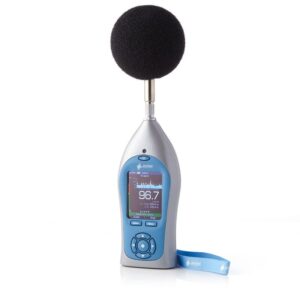What are decibels?
When you measure noise levels with a sound level meter, you measure the intensity of noise called decibel units (dB). A sound meter uses a display with a decibel range and resolution to approximate the ear’s dynamic range, usually the upper range rather than the quiet part. If you think about it, it would be very difficult to manufacture a sound level meter that had a linear performance, especially bearing in the mind the range of noise sources to be measured in a work environment. It would be tricky to keep an eye on those 14 digits varying in front of you! So, to express levels of sound meaningfully in numbers that are more manageable, a logarithmic scale is used, using 10 as the base, rather than a linear one. This scale is called the decibel scale.
What is the decibel scale?
The human ear is an extremely versatile and amazing hearing device. It has a clever in-built mechanism that reduces its own sensitivity as the sound level rises and it also has the remarkable ability to handle an enormous range of sound power levels. It can hear the sound of a pin dropping close-by as well as the roar of a jet engine far away.
Although the ear can distinguish the rise in level between one or two pins dropping, it cannot distinguish between 10,000,000,000,000 pins and 10,000,000,000,001 pins or even 10,100,000,000,000 because it is not a linear device. It can, however, distinguish the significant multiplying of the energy of the sound.
| Change in dB | Change in sound energy |
|---|---|
| 3 dB increase | sound energy is doubled |
| 3 dB decrease | sound energy is halved |
| 10 dB increase | sound energy is increased by a factor of 10 |
| 10 dB decrease | sound energy is decreased by a factor of 10 |
| 20 dB increase | sound energy is increased by a factor of 100 |
| 20 dB decrease | sound energy is decreased by a factor of 100 |
Did you know: A logarithmic scale is used when there is a large range of quantities. It is based on orders of magnitude, rather than a standard linear scale, so each mark on the decibel scale is the previous mark multiplied by a value.
On the decibel scale, the quietest audible sound (perceived near total silence) is 0 dB. A sound 10 times more powerful is 10 dB. A sound 100 times more powerful than near total silence is 20 dB. A sound 1,000 times more powerful than near total silence is 30 dB, 40 dB and so on.
Doubling of sound energy
Although the ear can distinguish the rise in level between one or two pins dropping, it cannot distinguish between 10,000,000,000,000 pins and 10,000,000,000,001 pins or even 10,100,000,000,000 because it is not a linear device. It can, however, distinguish the significant multiplying of the energy of the sound. When this sound is doubled this equates to a rise of 3dB (decibels), using a logarithmic scale. In other words: every increase of 3 dB represents a doubling of sound intensity or acoustic power. In a work context, this means that a small increase in the number of decibels results in a huge change in the amount of noise and, as such, the potential damage to a person’s hearing. The use of the dB unit makes it easier to measure decibels and monitor sound changes if we use these rules. The table below summarises this:
The basic rules for working with decibels
| Change in dB | Change in sound energy |
|---|---|
| 3 dB increase | sound energy is doubled |
| 3 dB decrease | sound energy is halved |
| 10 dB increase | sound energy is increased by a factor of 10 |
| 10 dB decrease | sound energy is decreased by a factor of 10 |
| 20 dB increase | sound energy is increased by a factor of 100 |
| 20 dB decrease | sound energy is decreased by a factor of 100 |
How loud are some common sounds in decibel measurements?
- Near-total silence – 0 dB
- A whisper – 15 dB
- A library – 45 dB
- A normal conversation – 60 dB
- A toilet flushing 75-85 dB
- A noisy restaurant – 90 dB
- Peak noise on a hospital ward – 100dB
- A baby crying – 110 dB
- A jet engine – 120 dB
- A Porsche 911 Carrera RSR Turbo 2.1 – 138 dB (see YouTube video of Porsche car noise tests using the Pulsar Nova Sound Level Meter)
- A balloon popping – 157 dB
How to add decibels together
Because sound pressure levels in decibels (dB) use a logarithmic scale we can’t just add two dB readings together. For instance, in a factory, if one machine’s noise level is measured at 90 dB(A) and then we start up a second machine also measuring 90 dB(A), the resulting noise is not 180 dB(A), instead, because we know that 3dB represents a doubling of the noise, 90dB + 90dB = 93dB.
You can use this quick reference table[1] to add noise levels together:
| Difference between two noise levels | Amount to add to the higher of the two noise levels (dB or dB(A)) |
|---|---|
| 0 | 3.0 |
| 0.1 – 0.9 | 2.5 |
| 1.0 – 2.4 | 2.0 |
| 2.4 – 4.0 | 1.5 |
| 4.1 – 6.0 | 1.0 |
| 6.1 – 10 | 0.5 |
| 10 | 0.0 |
Step 1: Find out the difference between two noise levels and then find the corresponding row in the left-hand column.
Step 2: Find the corresponding number in dB in the right-hand column.
Step 3: Add the number in the right-hand column to the highest of the two-decibel measurements you have.
When the difference between two-decibel measurements is 10dB(A) or above, the amount added is Zero, this is because the contribution to the overall noise of the lower reading is not perceived by the human ear and therefore no adjustment factor is needed. For example, if your workplace noise level is 95 dB(A) and you add another process or piece of machinery that measures 80dB(A) on its own, the workplace noise level will still be 95dB (A).
A-weighting dB(A) and C-weighting dB(C)
Noise measurements relating to loud noise at work are more normally given in dB(A) or dB(C) – these are frequency weightings that are applied to the decibel measurements (A and C frequency weightings), in effect, they are decibel scale readings that attempt to replicate the sensitivity of the human ear to different frequencies of sound.
- A-weighting (A-frequency-weighting): ‘A’ Weighting is the most commonly used and covers the full frequency range of 20Hz all the way up to 20 kHz. The human ear is most sensitive to sound frequencies between 500 Hz and 6 kHz whilst at lower and higher frequencies the human ear is not very sensitive. The ‘A’ weighting adjusts the sound pressure readings to reflect the sensitivity of the human ear and is therefore mandated all over the world for hearing damage risk measurements.
- C-weighting (C-frequency-weighting): The C-weighting looks more at the effect of low-frequency sounds on the human ear compared with the A-weighting and is essentially flat or linear between 31.5Hz and 8kHz, the two – 3dB or ‘half power’ points. Peak Sound Pressure Measurements are made using the C- frequency weighting. Measurements are typically displayed as dB(C) or dBC. Or for example as LCeq, LCPeak, LCE – where the C shows the C-weighting.
-

7-year
Warranty
Nova Noise at Work Sound Level MeterFrom: £1,605.00 (Ex. VAT/GST)
Find out how to measure decibels
People measure decibels for noise at work purposes with an integrating sound level meter or noise dosemeter. Pulsar Instruments Noise at Work training courses provides everything you need to know about using these sound measurement instruments to measure and manage workplace noise so you can stay compliant with health and safety Noise Regulations. We carry out several UK-based courses throughout the year and also provide bespoke in-company training.
Contact us for more details.
References
[1] Noise – basic information OSH Answers Facts Sheets. Canadian Centre for Occupational Health and Safety.


